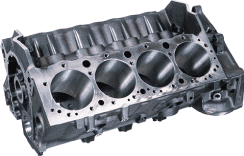Cylinder honing is just one element in high-performance engine preparation that is often taken for granted, yet it can be an effective means of not only helping to maintain proper oil control, but increasing horsepower, as well. Most high-performance enthusiasts understand that when an engine is rebuilt and new rings are installed, the block will need to be properly honed in a cross-hatch pattern, but few realize that block hardness, stroke, ring material and tension, and application all need to considered prior to any work being performed.

In high-end racing engines, the difference between proper and improper cylinder honing operations can equate to as much as 30 horsepower, according to experts. When proper honing has been performed, the cylinder bore finish results in an engine that offers both superior ring seal and extended ring life. It is often a delicate balance of having sufficient surface area to allow the piston rings to seal, but not so great that oil retention and ring lubrication are compromised. When visually inspecting cylinders, a freshly honed cylinder looks fairly rough, due to the honing process that leaves a cross-hatch pattern, while a used cylinder features a “glazed” surface with little or no visible crosshatch, depending upon wear.
When a freshly honed cylinder is viewed microscopically, the surface appears as many “peaks” and “valleys”. The “peaks” are the highest point of the surface, which makes contact with the rings. The “valleys” are areas that have been cut by abrasives during the honing process. Once a fresh engine is fired, the tops of the “peaks” are literally sheared off as the rings seat into the cylinders, creating a “plateau” for the rings to ride over and a light film of oil that is retained in the “valleys”.
In order to achieve proper cylinder wall prep, three areas are typically scrutinized by the engine builder and/or machinist; finish, cross-hatch and distortion, all with the goal of achieving superior ring seal and maximum performance. High-performance engine shops use a profilometer to scrutinize cylinder wall finish, formerly referred to as “RA” (Roughness Average). The sophisticated electronic tool features a diamond-tipped stylus, similar to the needle found on a vinyl record turntable, that drags across the surface measuring the distribution of peaks and valleys. A profilometer provides modern, defined descriptions of cylinder bore finish that include “RPK” (Reduced Peak Height), “RVK” (Reduced Valley Depth) and “RK” (Core Roughness Depth), which is based on both the “RPK” and “RVK” measurements.
Since “RVK” refers to the depth of the valleys that retain oil, it is directly related to oil consumption. Excessive “RVK” promotes high oil consumption, while insufficient amounts can result in excessive ring and cylinder wear, according to the experts at Hastings Manufacturing. As described previously, final cylinder wall finish is highly dependent upon a wide variety of factors. High-end racing engines, in some instances, are machined with very deep “valleys” to retain a larger volume of oil and “peaks” with little surface area for the rings to ride on.
During cylinder honing, the cross-hatch angle, controlled by how fast the honing head rotates and how quickly it cycles up and down, is scrutinized as well. The angle can be checked using a protractor or a practical and creative business card from Total Seal that doubles as a flexible, plastic protractor. To check cross-hatch angle with the special business card, begin by removing the translucent backing off of the card. Follow by pressing it into the curvature of the cylinder and aligning the top edge of the card with the deck surface. Proceed by then reading the card by doubling the amount that matches the cross-hatch. For example, if it reads 20 degrees, the true angle is 40 degrees.
The cross-hatch angle should be the same the full length of the cylinder, and while the most common angle is roughly 45 deg., it may vary depending on ring tension or stroke length. Some builders prefer as little as a 20-30 degree cross-hatch when using low-tension oil rings, for example, because it reduces the amount of oil movement up and down the cylinder. On the other hand, long stroke engines may perform better with a larger, 60 degree cross-hatch as the angle provides increased oil movement to the top of the bore and returns oil more rapidly to the pan, although blow-by may increase somewhat, according to the experts at Total Seal.
When a high-performance engine block is honed, it is important that a torque plate be installed. A torque plate, when used with the proper head gasket and fasteners, simulates the loads placed on the block when the cylinder head is installed, and therefore, helps achieve rounder and truer cylinder bores during the honing process, keeping bore distortion to a minimum. Most high-performance engine shops carry torque plates for most popular engines.
Naturally, the rounder and truer the cylinders are, the easier the rings can conform and the better they will seal to the cylinder. It is not uncommon for qualified shops with the proper equipment to achieve as little as .0005″ of bore distortion. Cylinder bores may be inspected using a dial bore gauge with a torque plate in place.
After machining operations are completed, it is crucial that the engine be thoroughly scrubbed with soap and water. Nothing is more detrimental to an engine than dirt and debris. Wiping the cylinders using a white, WD-40 soaked cloth and then inspecting the cloth will provide insurance that the cylinders are truly clean.
A complete list of cylinder honing procedures, recommendations and tech tips are available from manufacturers including Hastings, Total Seal, and Sunnen.